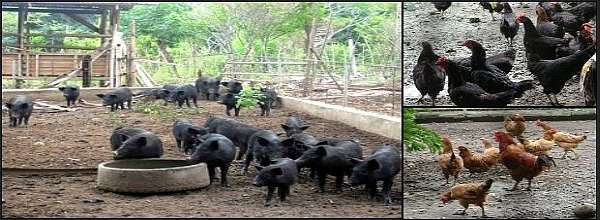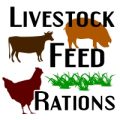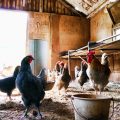Why choose native?
According to the Food and Fertilizer Technology Center for the Asian and Pacific Region, native animals have provided valuable contributions in the cultural, social, and economic status of farming communities in the rural areas. Aside from providing them with an alternative source of livelihood, these animals have been known to contain high quality protein.

The growing population around the world prompted the demand for producing more which led to intensive farming, making use of exotic commercial breeds and hybrids. But with people becoming more conscious of their health, natural products exhibit potentials for choosing native chicken and pig when it comes to animal production.
In the country, native pigs can be found in many parts of the country like Abra, Kalinga, Mt. Province, Marinduque, Quezon, Iloilo, and Davao – mostly in far-flung villages or barangays. These pigs are known for their ability to grow and reproduce even under adverse conditions and are more resistant to parasites and common diseases as compared to the standard or imported breeds. Most of all, they are budget-friendly especially to small-scale farmers who cannot afford to buy commercial feeds because they only require low-cost production inputs in terms of housing and feeding. Locally available resources found in many areas including gabing san fernando, sakwa, kamote and kamote tops, kangkong, banana trunks and leaves, copra, rice bran, cooked cassava and kamoteng kahoy, pongapong, as well as madre de agua can be fed to them. Meanwhile, herbal plants can act as substitutes to ease common diseases and illnesses like ipil-ipil seeds and niyog-niyogan for deworming, madre cacao or kakawate for skin parasites, sambong for respiratory problems, and star apple and guava leaves concoction for scouring.
For native chickens, different kinds of breeds that exist in the Philippines include the Banaba in Batangas, Paraoakan in Palawan, Joloano in Mindanao, and Darag in Panay Island. Native chickens possess almost the same advantageous characteristics like the native pigs. But aside from those, they also have the ability to look for their own foods, hence intensive production is not that much needed. Feeding them is easy as readily-available local feeds such as corn, palay, rice bran, kitchen leftovers, grasses or even insects and worms are palatable to them. They can also be beneficial for those who are planting other agricultural crops because they aid in improving soil fertility.
Aside from providing nutritious foods for the family, raising these native animals can become an additional source of income for small-scale farmers especially in rural areas. They are used in ritual practices, as cure for the sick especially in the Northern areas, as payment for debts, or even as a hobby because they are very easy to manage. They are usually in demand during feasts and occasions because of their distinct taste. Native pigs, for example, when roasted and turned into lechon, have crispier skin and tastier meat which suits the Filipinos’ palates. With a leaner and tastier meat, alongside associated healthy benefits, native production can draw higher demand and command a better price in the market.
Major identified setbacks, however, of venturing into native animal production are slow growth rate and inconsistencies in production performance. So why still endeavor in this undertaking?
Solution to these problems according to experts from BAI-National Swine and Poultry Research and Development Center (NSPRDC) could be through proper selection of the best genetic resource for reproduction. Selection is highly encouraged because it would help in the sustainability and conservation of the native pigs and chickens. The process involves selecting the animals possessing the desirable traits which are then used as breeders.
What are BT Blacks?
With years of thorough and careful selection for the best genetic resources for native pig production, NSPRDC was able to develop the BAI-Tiaong Black Pigs, or known as the BT Blacks.
Since the late ‘90s, NSPRDC has been maintaining native pigs coming from Benguet, Marinduque and Quezon Province. These native pigs were bred with each other and the ones with the desirable qualities are selected to be the next breeders. Hence, the BT Blacks were born. They are native pigs which are improved through selection and have shown better performance than most pure native pigs found in the country. This includes faster growth and more number of offsprings without losing the desirable traits. Their distinctive features are their pure black color and medium-sized ears. BT Blacks have an average litter size of 8 piglets while 7 piglets for weaning size. Birth weight averages 750 grams.
Seeing the potential of the native pigs as another source of income for farmers, the BAR-funded project titled “Evaluation and Commercialization of Philippine Native Pigs” was implemented. BT Blacks have been distributed to different farmer-cooperators in Quezon, Laguna and Batangas to see the income potential of raising them based on the housing ang management practices developed by NSPRDC. Instead, the farmer-cooperators chose to adopt their own housing and feeding practices, and yet still resulted in promising outcomes.
Further studies are needed to realize the full potential of the BT Blacks. As of now, 10 farmer-cooperators from Tiaong, Dolores, and Tagkawayan in Quezon and Paete in Laguna are raising BT Blacks and are being monitored by NSPRDC. They are now becoming sources of breeder animals sold in different parts of Luzon. Some of them are even saying that they are in need of more production as demand for native pigs for lechon is now increasing. NSPRDC encourages those provinces with existing native pigs to improve them through proper breeding and selection, housing, feeding and over-all management so that there will be more sources of breeders all throughout the country. Currently, BAI-Animal Products and Development Center (APDC) based in Marulas, Valenzuela explores other market potential for native pigs aside from lechon such as processed meat and leather, among others.
Government support is an essential component in order for native production be sustainable for our farmers. The Department of Agriculture (DA) is responsible in ensuring that the country’s native chickens and native pigs are conserved. In 2010, the Bureau of Animal Industry (BAI) launched the Philippine Native Animal Development (PNAD), an initiative that will help promote the conservation and utilization of domesticated native animals as food. The said project is aimed at highlighting the significant role that native animals play especially in providing food and income-generating activities for the Filipino people. In view of this, the Bureau of Agricultural Research (BAR), through its Technology Commercialization Division (TCD), has been supporting related R&D projects geared towards the promotion and development of our own native chickens and native pigs.
———
For more information regarding native chicken and pig production and BT Blacks, you may contact Dr. Rene Santiago or Dr. Flomella Caguicla of BAI-NSPRDC at (042) 585-7727 or email them thru: bai_nsprdc@yahoo.com
References:
1. FFTC Annual Report 2010. Retrieved from www.fftc.agnet.org/files/lib_articles/20120103110958/ac2010f.pdf
2. Powerpoint presentations presented by Dr. Rene Santiago and Dr. Flomella Caguicla during the seminar series held at BAR last 24 September 2012.
by Anne Camille B. Brion, www.bar.gov.ph






Hello po, we are selling native pigs in San Pablo Laguna 09663669678
very in-demand po nowadays ang native pig
many people talked about the importance of these native animals and i like that, but my interests go to keeping of local ducks. any giude for raising them?
I just read ,something it could finance,breeding native pigs.how is it.any information,tel,to know the detail pls How
Mam Ruth,San po loc.nyo nag hahanap po ako na mabibilhan.loc .ko po south.part po ng muntinlupa
for buyer in pampanga pls. call 09281723298 or email dsdavidjr6652@gmail.com. we are from lubao limited supply lang po
Good pm po.Just incase po na mag reproduce tayo native pig.may assurance po ba tau ng market nito?
Sir/madam,mayroon po bang volume buyer ng native pigs?just started my piggery and in a year or two medyo marami na ciguro akong pwedeng inventa God willing ,so sana mabigyan nyo ako ng buyer pls,thank you c jun my email erjun57@yahoo.com.taga Bonalonan pangasinan po